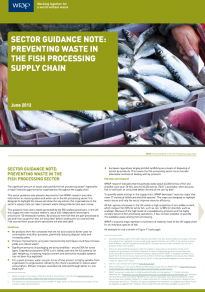Supportive Policy Environment for Processing Plants
Policy intervention can help with the reduction of food loss and waste (FLW). Below includes an overview of several studies that identify where policy intervention will be useful.
Case Study: Fish Waste Production in the United Kingdom
Currently, much of the fish waste generated in the UK is of poor quality; it is not hygienically handled and storage temperatures are often uncontrolled, leading to rapid spoilage. In order to yield the best quality for many of these co-products, which in turn would generate the most income, fish waste would have to be handled and stored under hygienic conditions and suitably preserved. Investment in freezing equipment may be necessary for some products. There is a gulf between the science, together with the technical possibilities of fish waste utilization, and commercial reality in the UK. Although the options described are technically feasible, many are unproven in the UK and they are not necessarily commercially feasible. Commercial feasibility will depend on finding the necessary investment capital, which in turn will require assurance of supplies of raw material and of markets for the products, and of a favorable balance between revenue and costs.
Case Study: Preventing Waste in the Fish processing Supply Chain
Case Study: Preventing Waste in the Fish processing Supply Chain
According to another study of fish processing waste in the UK, the fish processing sector has an opportunity to minimize all types of waste to reduce costs and benefit the environment. For most processors, measurement is the first step towards effective management. Because of the small scale and remote location of many processors, landfill derogations can be given by regulators. Moving waste material up the waste hierarchy (to avoid the ‘Disposal’ route will provide environmental benefits and avoid costs. These should be considered on a case-by-case basis by individual processors or, where feasible, by processors working together.
Proposed solutions include:
- Build on export markets for by-products, such as fish heads, or the wider use of fish frames as flavouring where these offer economic benefits compared with fish-meal processing.
- Small processors and those in remote locations could benefit from collaborative programmes designed to optimize collection or exploit market opportunities.
- Develop markets for shell products that could include aggregates, filter media and use for decorative purpose. Regulatory clarification on ‘free of flesh’ shell is required to realize this potential.
- Implement total productive maintenance (TPM)
- Measure ‘overall effective efficiency’ (OEE) of critical processes determined by Availability x Performance x Quality and aim for a metric in excess of 75%
- Look for bottlenecks that might be caused by poor line balance due to an uneven spread of workload between individuals and/or machines.
Case Study: Wasted Seafood in the United States
A study of fish waste in the US proposes that in the seafood processing seafood should be packaged into smaller portion sizes for consumers and consideration should be given to the use of new labelling technologies that track a product's time-temperature exposure and provide indicators that it may have become unsafe. Although at the time, such technology was not yet in wide commercial use.
Key Publications
The report estimates the types and quantities of fish waste generated in the different sectors, from catching to processing, and summarizes the current utilization or disposal of that waste. | |
Preventing Waste in the Fish Processing Supply Chain Included are key results from WRAP research on reducing waste and water use in fish processing, and highlights issues and key actions that supply chain organizations can take to prevent waste and save money. | |
Nearly half of edible U.S. seafood supply was lost annually between 2009-2013. This publication discusses the need for lost seafood to be monitored as part of the seafood supply chain. |
More Resources
More Resources
31 October 2023














